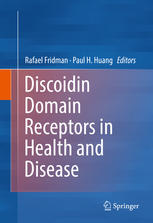گیرنده های دامنه دیسکودین در سلامت و بیماری ۲۰۱۶
Discoidin Domain Receptors in Health and Disease 2016
دانلود کتاب گیرنده های دامنه دیسکودین در سلامت و بیماری ۲۰۱۶ (Discoidin Domain Receptors in Health and Disease 2016) با لینک مستقیم و فرمت pdf (پی دی اف)
| نویسنده |
Paul H. Huang, Rafael Fridman |
|---|
| تعداد صفحهها |
355 |
|---|---|
| نوع فایل |
|
| حجم |
12 Mb |
| سال انتشار |
2016 |
89,000 تومان
معرفی کتاب گیرنده های دامنه دیسکودین در سلامت و بیماری ۲۰۱۶
فعل و انفعالات سلولی با ماتریکس خارج سلولی اطراف (ECM) نقشی اساسی در هدایت رفتار طبیعی سلول، از رشد تا تمایز و عملکرد بافت ایفا می کند. در سطح سلولی، هموستاز اندام ها به ارتباط سازنده بین سلول ها و ECM بستگی دارد، که در نهایت منجر به مجموعه فنوتیپی می شود که هر نوع سلولی را در یک ارگانیسم مشخص می کند. عدم ایجاد این فعل و انفعالات طبیعی و تفسیر سیگنال های صادر شده از ECM یکی از دلایل اصلی در توسعه غیرطبیعی و پاتوژنز بیماری های متعدد است. برای شناسایی و دستکاری سیگنال های بیوفیزیکی که از طریق تداخل بین سلول ها و ECM تولید می شوند، سلول ها گیرنده های خاصی را تکامل داده اند، که در میان آنها مجموعه منحصربه فردی از گیرنده های تیروزین کیناز (RTKs) شناخته می شود که به عنوان گیرنده های دامنه Discoidin (DDRs) شناخته می شوند. DDR ها تنها RTK هایی هستند که به طور خاص به کلاژن، یک جزء پروتئینی اصلی ECM متصل می شوند و آن را فعال می کنند. از این رو، DDR ها بخشی از شبکه های سیگنالینگ هستند که اطلاعات را از ECM ترجمه می کنند و بنابراین تنظیم کننده های کلیدی تعاملات سلول-ماتریس هستند. تحت شرایط فیزیولوژیکی، DDR ها هموستاز سلولی و بافتی را با اثر بر حسگرهای کلاژن کنترل می کنند. انتقال سیگنال هایی که قطبیت سلولی، مورفوژنز بافت، تمایز سلولی و رسوب کلاژن را تنظیم می کنند. DDRها نقش عمده ای در بیماری هایی دارند که با ناهنجاری های جزء استرومایی مشخص می شوند، که منجر به رسوب غیرطبیعی کلاژن و پاسخ فیبروتیک در نتیجه می شود که عملکرد طبیعی اندام ها را در بیماری های سیستم قلبی عروقی، ریه ها و کلیه ها مختل می کند. در سرطان، DDR ها توسط سلول های تومور و سلول های استرومایی ربوده می شوند تا ارتباط طبیعی سلول-کلاژن را مختل کنند و برنامه های پیش از تومور را آغاز کنند. نکته مهم این است که بسیاری از انواع سرطان جهش های DDR را نشان می دهند که تصور می شود عملکرد گیرنده را تغییر می دهند و به توسعه سرطان کمک می کنند. بنابراین، پیوند علّی قوی بین تغییر عملکرد RTK و بیماری، امروزه به توسعه مهارکننده های تیروزین کیناز خاص تبدیل شده است که DDRs را برای حالت های مختلف بیماری هدف قرار می دهند. علیرغم انباشت شواهدی که اهمیت DDR در سلامت و بیماری را برجسته می کند، هنوز چیزهای زیادی برای یادگیری در مورد این گروه های منحصر به فرد وجود دارد، حتی امروزه کمبود ادبیات پزشکی برای کتابی که صرفاً به DDR اختصاص داده شده است وجود ندارد. این اولین جلد جامع اختصاص داده شده به DDR است که یک شکاف در این زمینه را پر می کند و به علاقه مندان جامعه علمی خدمت می کند تا درباره این گیرنده های مهم در سلامت و بیماری بیشتر بیاموزند.



